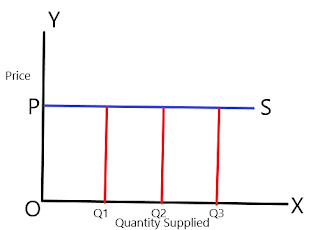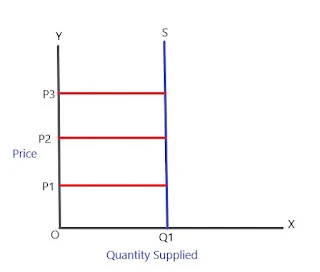Elasticity of Supply in the Context of Public Health Service
Just as elasticity of demand is significant in understanding consumer behavior, elasticity of supply holds equal significance in comprehending the dynamics of providing public health services. Elasticity of supply measures how responsive the quantity supplied of a good or service is to changes in various factors, shedding light on the adaptability of the supply side in public health economics.
Some of the major types of Elasticity of Supply in the context of Public Health Economics are explained as follows:
- Price Elasticity of Supply (PES): This metric quantifies the percentage change in the quantity supplied of a service in response to a one percent change in its price. When PES is elastic (PES > 1), a slight price alteration leads to a proportionally larger change in the quantity supplied. This concept resonates in public health when considering services like medical equipment production. Elastic PES implies that manufacturers can quickly ramp up production in response to price changes, ensuring a flexible supply to meet varying demands.
- Resource Elasticity of Supply (RES): Resource availability greatly influences the supply of public health services. RES assesses the responsiveness of quantity supplied to changes in resource availability. When resources are abundant, supply can expand rapidly, indicating an elastic response. In public health, RES aids in predicting how readily healthcare institutions can adapt their provisioning to accommodate resource fluctuations, such as during pandemics.
- Labor Elasticity of Supply (LES): Healthcare services rely heavily on skilled professionals. LES examines how the quantity supplied adjusts in relation to changes in labor availability, reflecting the elasticity of the healthcare workforce. Elastic LES implies that the healthcare workforce can swiftly scale up or down based on need, such as during emergency situations.
Visualizing the concept of elasticity of supply in public health services:
| Type of Elasticity | Scenario | Implication |
|---|---|---|
| Price Elasticity of Supply | Elastic (PES > 1) | Slight price changes result in significant changes in quantity supplied. Manufacturers can rapidly adapt production. |
| Inelastic (PES < 1) | Quantity supplied responds minimally to price changes. Adaptation to price fluctuations is limited. | |
| Resource Elasticity of Supply | Elastic (RES > 1) | Resource abundance enables flexible and rapid supply adjustments, aiding response to changing demand. |
| Inelastic (RES < 1) | Resource scarcity constrains supply adaptability, potentially leading to challenges during demand spikes. | |
| Labor Elasticity of Supply | Elastic (LES > 1) | Healthcare workforce can swiftly scale up or down, meeting fluctuating demand while maintaining quality. |
| Inelastic (LES < 1) | Labor availability limits supply responsiveness, posing challenges in managing varying healthcare needs. |
1. Price Elasticity of Supply (PES) in Public Health Economics:
Price Elasticity of Supply (PES) stands as a cornerstone concept in public health economics, casting a spotlight on the dynamic interplay between the price of a public health service and the responsiveness of its supply. Much like its counterpart in demand, PES elucidates the degree to which the quantity supplied of a public health service reacts to changes in its price, all while holding other factors constant. This measurement is instrumental in assessing how the supply side of public health adjusts to shifts in cost.
The formula to calculate Price Elasticity of Supply (PES) is succinctly defined as:
ES or PES = Percentage Change in Quantity Supplied / Percentage Change in Price
Where:
Percentage Change in Quantity Supplied = This component captures the percentage shift in the quantity supplied of the public health service under consideration.
Percentage Change in Price = This segment encapsulates the percentage alteration in the price of the public health service.
PES, much like the Price Elasticity of Demand (PED) counterpart, is a numerical representation that guides public health economists and policy makers in understanding the magnitude of supply responses to price fluctuations. A high PES value indicates a service with an elastic supply, where a slight price modification results in a proportionally larger change in the quantity supplied. Conversely, a low PES suggests an inelastic supply, characterized by less pronounced adjustments to price shifts.
Types or Degrees of Price elasticity of Supply in Public Health Services
1. Perfectly Elastic Supply (Es = ∞): Perfectly elastic supply depicts a theoretical scenario where the quantity supplied responds infinitely to even the slightest change in price. While this scenario is mostly imaginary, it paints a clear picture of a supply that can be expanded or contracted without constraint in response to minimal price shifts.
For instance, consider the supply of disposable face masks during a sudden surge in demand due to an infectious disease outbreak. Manufacturers could potentially adjust production rapidly to meet the increased demand, showing characteristics of perfectly elastic supply.
Along the y-axis and x-axis of the preceding graph, the price and quantity supplied are displayed, respectively. When the change in price is negligible, there is a substantial change in the quantity supplied. PS is the perfectly elastic supply curve, that is, Es = ∞.
2. Perfectly Inelastic Supply (Es = 0): Perfectly inelastic supply illustrates a situation where alterations in price have absolutely no effect on the quantity supplied. In the realm of public health services, this would signify an unchanging supply regardless of price shifts. While this degree of inelasticity is rarely encountered, it shows that certain health services might remain static in quantity regardless of changes in their costs.
Suppose there is a highly advanced and rare surgical procedure that is required to treat a unique medical condition affecting only a handful of individuals worldwide. Due to its extreme rarity and complexity, the supply of this specialized treatment might be entirely fixed and unresponsive to changes in its price.
In the figure above, Q1S represents perfectly inelastic supply. It is perpendicular to the y axis. It indicates that the quantity supplied remains unchanged at prices OP1, OP2, and OP3, i.e. OQ1.
3. Unitary Elastic Supply (Es = 1): Unitary elastic supply manifests when the percentage change in the quantity supplied matches the percentage change in price. This balance signifies a proportional response, whereby supply adapts to price shifts in a one-to-one ratio.
For instance, if the price of vaccines used for routine immunization increases by 10%, and the supply of those vaccines also expands by 10%, this exemplifies a unitary elastic supply.
Along the y-axis and x-axis of the preceding graph, the price and quantity supplied are displayed, respectively. It demonstrates that the ratio of quantity change to price change is equal. The supply curve has unitary elasticity. I.e. Es=1
4. Relatively Elastic Supply (Es > 1): Relatively elastic supply characterizes a situation where the percentage change in quantity supplied exceeds the percentage change in price. This degree of elasticity suggests that supply is responsive to price fluctuations, with quantity adjustments surpassing the shifts in cost.
For example, if the price of flu vaccines rises slightly due to increased demand, but the quantity supplied increases by a larger proportion, this demonstrates relatively elastic supply.
Along the y-axis and x-axis of the above graph, the price and quantity supplied are shown, respectively. This indicates that the ratio of change in quantity supplied exceeds the ratio of change in price. SS represents a supply curve that is relatively elastic. Es>1
5. Relatively Inelastic Supply (Es < 1): Relatively inelastic supply signifies that the percentage change in quantity supplied is lower than the percentage change in price. This less responsive nature of supply implies that changes in cost have a more substantial impact on the quantity supplied.
For example, there is a shortage of skilled medical professionals during a public health crisis. If the wages of these professionals increase significantly due to demand, but the quantity of available medical staff only increases slightly, this reflects relatively inelastic supply.
Along the y-axis and x-axis of the preceding graph, the price and quantity supplied are depicted, respectively. It indicates that the ratio of price change is greater than the ratio of quantity change. SS represents a supply curve that is relatively inelastic. I.e.; Es<1
2. Resource Elasticity of Supply (RES)
Resource Elasticity of Supply (RES) is a critical concept within the framework of public health economics, offering insights into the adaptability of supply in response to changes in resource availability. Resources encompass a wide range of factors such as raw materials, facilities, equipment, and funding, all of which profoundly impact the provision of public health services. RES measures how the quantity supplied of these services responds to fluctuations in the availability of these essential resources.
In the context of public health services, RES plays a significant role in understanding the dynamics of supply adaptation. When resources are abundant, healthcare institutions can seamlessly expand their provisioning of services, ensuring a more responsive supply. Conversely, when resources are scarce, supply adjustments might be constrained, potentially leading to challenges in meeting demand. RES allows for a quantifiable assessment of how sensitive the quantity supplied is to changes in resource availability.
Let’s consider the example of ventilators during a pandemic. During normal circumstances, the supply of ventilators might be in equilibrium with the existing resource availability. However, during a sudden surge in COVID-19 cases, the demand for ventilators spikes dramatically. A high RES would indicate that healthcare institutions can rapidly adjust the supply of ventilators by reallocating resources, increasing production, or sourcing additional resources. This flexibility helps ensure that the critical healthcare need for ventilators can be met, even amidst unexpected surges in demand.
The formula to calculate Resource Elasticity of Supply (RES) is:
RES = Percentage Change in Quantity Supplied / Percentage Change in Resource Availability
Where:
Percentage Change in Quantity Supplied: This represents the percentage shift in the quantity of the public health service supplied in response to changes in resource availability.
Percentage Change in Resource Availability: This denotes the percentage change in the availability of resources required for the provision of the public health service.
A high RES value (> 1) signifies an elastic response, where the quantity supplied can be adjusted significantly in response to changes in resource availability. A low RES value (< 1) indicates a less elastic response, implying that the quantity supplied is less sensitive to resource fluctuations.
3. Labor Elasticity of Supply (LES)
Labor Elasticity of Supply (LES) holds profound relevance in the domain of public health services, where the healthcare workforce plays a pivotal role in service provision. LES delves into how the quantity supplied of healthcare services adjusts concerning changes in labor availability, showcasing the workforce’s elasticity in responding to varying demands.
Healthcare services heavily rely on skilled professionals, and their availability can significantly impact the responsiveness of supply. Elastic LES indicates that the healthcare workforce can rapidly scale up or down based on need. This adaptability is crucial during emergency situations, where the workforce must swiftly adjust to accommodate increased patient loads.
Consider a scenario where a region is hit by a natural disaster, leading to a flow of injured individuals requiring medical attention. Elastic LES would imply that hospitals and medical facilities can promptly mobilize additional healthcare professionals, including doctors, nurses, and support staff, to cater to the increased demand. This rapid response ensures that quality healthcare can be provided even during critical situations.
The formula to calculate Labor Elasticity of Supply (LES) is:
LES = Percentage Change in Quantity Supplied / Percentage Change in Labor Availability
Where:
Percentage Change in Quantity Supplied: This represents the percentage change in the quantity of the public health service supplied in response to changes in labor availability.
Percentage Change in Labor Availability: This indicates the percentage change in the availability of skilled labor required for the provision of the public health service.
A high LES value (> 1) signifies an elastic response of the healthcare workforce, implying the capacity to quickly adjust the quantity supplied based on labor availability changes. On the other hand, a low LES value (< 1) indicates a less elastic response, suggesting limitations in rapidly adapting to fluctuations in the availability of skilled labor.








.jpg)


Please leave your comments or ask your queries here. The comments shall be published only after the Admin approval.